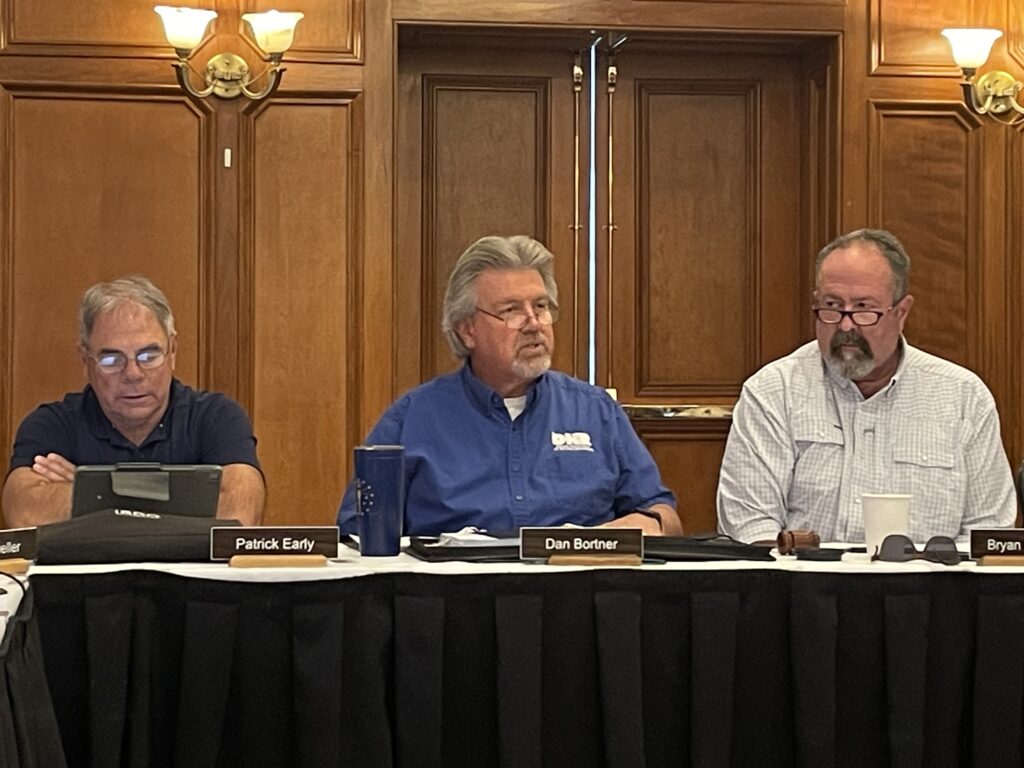Natural Resources Commission member Patrick Early (left), department Director Dan Bortner and commission Chair Bryan Poynter at a commission meeting on Tuesday, Sept. 17, 2024. (Leslie Bonilla Muñiz/Indiana Capital Chronicle)
Indiana’s Natural Resources Commission on Tuesday approved preliminary rules for a new, lawmaker-mandated bobcat trapping season, and finalized statewide river otter trapping regulations.
Commission leader Bryan Poynter called the bobcat work a “heavy lift,” speaking from the ballroom at the Fort Harrison State Park Inn in Marion County.
The Department of Natural Resource’s proposed changes would include establishing a bobcat trapping season in 40 southern Indiana counties, with a bag limit of one bobcat per trapper and a season quota of 250 bobcats. It would run November to January.
Public comments can be submitted here by clicking on “Comment on this rule.”
Biologist Geriann Albers said the department based the limits on a data model created in collaboration with Purdue University.
Department of Natural Resources Biologist Geriann Albers speaks at a commission meeting on Tuesday, Sept. 17, 2024. (Leslie Bonilla Muñiz/Indiana Capital Chronicle)
The model’s assumptions were “very conservative,” she said.
“We’re very confident that that number is sustainable and is not going to negatively impact our bobcat population,” Albers told the commission.
The season is limited to “established” populations in the south, for example, because bobcat populations further north are still considered “emerging.”
The department also recommended other amendments: letting legally acquired bobcats and parts to be sold, letting bobcats found dead to be kept for personal use with a permit, and more.
Traps would be limited to cage, foothold and cable device traps.
“We know those three types have been tested on bobcats, and they’re humane, efficient and selective for bobcats,” Albers said.
She told the Capital Chronicle that the department’s efforts related to bobcat trapping go back at least four years. Rulemaking for a brand-new season is complex, she said, because it involves plenty of data and other moving parts.
In 2019, the department weighed a bobcat season but dropped the idea after public backlash. Lawmakers stepped in earlier this year to require a season.
The department’s Fish and Wildlife Division aimed for balance.
“People like to participate in hunting and trapping, but we also want to strike that balance of (bobcats) still being available for people to view or photograph and things like that,” Albers said. “So we’re trying to maximize the outdoor activity that’s available, but in a sustainable way.”
Fort Benjamin Harrison State Park’s inn on Tuesday, Sept. 17, 2024. (Leslie Bonilla Muñiz/Indiana Capital Chronicle)
The commission approved preliminary adoption of the amendments by voice vote. Public comment comes before a final vote.
And it O.K.’d final rules for an expanded river otter trapping season, a development that Poynter dubbed “one of the biggest success stories that we’ve had in Indiana in a long time.”
Hoosier river otters were few and far between by the 1900s, and were even classified as extinct in Indiana in 1942, according to Purdue University.
The department began a reintroduction program in 1995, releasing 303 river otters into the state before the new millennium, according to its website. Most came from Louisiana, per Albers.
By 2005, the population had recovered so much that river otters were removed from the state-endangered list. The department opened its first limited season for the creatures in 2015.
Now, the department estimates there are upwards of 8,000 river otters in Indiana.
“As … otters have kept expanding, we’ve upped that quota once, and we started adding more and more counties, and we were kind of at a tipping point where most of the state was already open and there was only some counties that weren’t,” Albers said.
And, Hoosiers having “otter issues” can take them during the season instead of having to get other permits. River otters commonly get into small ponds stocked with fish, she said.
“Otters see those kind of as buffets,” she remarked.
The changes establish a statewide trapping quota of 750 river otters with an individual bag limit of two. The season extends from mid-November to mid-March.
GET THE MORNING HEADLINES DELIVERED TO YOUR INBOX

